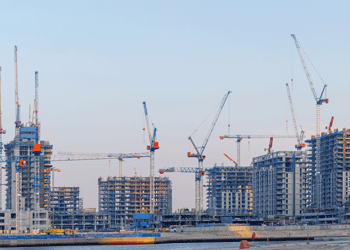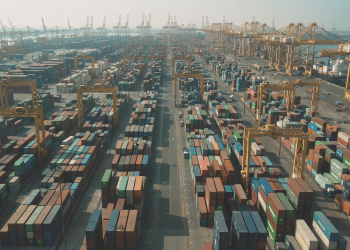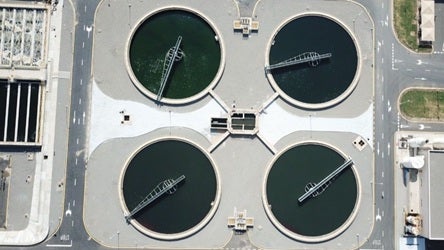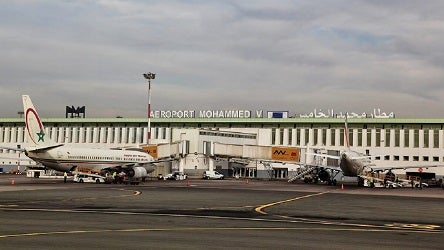Strategic Adnoc projects register notable progress
11 April 2023
This package on the UAE's upstream sector also includes:
 > Adnoc tenders key unconventional gas project
> Adnoc tenders key unconventional gas project
> Adnoc advances strategic Lower Zakum projects
> Adnoc L&S wins $2.6bn logistics services contract
> Adnoc and BP offer to buy Israeli gas firm stake
> Adnoc starts Fujairah CO2 reduction project
> Adnoc receives bids for key Estidama project packages
> Adnoc tenders Upper Zakum oil field development
Abu Dhabi National Oil Company (Adnoc) is making considerable progress with big-ticket projects key to attaining its strategic goals of 5 million barrels a day (b/d) of oil production capacity by 2027 and 3 billion cubic feet a day (cf/d) of gas by the end of this decade.
The state energy giant has been allocated a capital expenditure budget of $150bn for 2023-27. It made clear its intention to advance strategic projects by deploying contractors at the start of the year to begin initial work on its biggest scheme – the Hail and Ghasha sour gas development.
Hail and Ghasha sour gas production
In January, Adnoc signed pre-construction services agreements (PCSAs) with France-headquartered Technip Energies, South Korean contractor Samsung Engineering and Italy’s Tecnimont for the Hail and Ghasha onshore package.
Italian contractor Saipem, Abu Dhabi’s National Petroleum Construction Company (NPCC) and state-owned China Petroleum Engineering & Construction Company (CPECC) secured a PCSA for the offshore package.
While the onshore and offshore PCSAs awarded to the two consortiums by Adnoc are valued at $80m and $60m, respectively, the engineering, procurement and construction (EPC) packages are estimated to be worth $5.5bn and $5bn.
As part of the PCSAs, the contractors are required to perform initial detailed engineering and procurement for important long-lead items. Based on proposals to be submitted later this year, Adnoc is expected to award the same contractors the main EPC works on the Hail and Ghasha project.
Production from the Ghasha concession, where the Hail and Ghasha fields are located, is expected to start by 2027, ramping up to more than 1.5 billion cf/d before the end of the decade.
The Hail and Ghasha fields, along with the Hair Dalma, Satah, Bu Haseer, Nasr, Sarb, Shuwaihat and Mubarraz fields, are located in Abu Dhabi’s offshore Ghasha concession.
Adnoc holds the majority 55 per cent stake in the Ghasha concession. The other stakeholders are Italian energy major Eni with 25 per cent; Germany’s Wintershall Dea with 10 per cent; and Austria’s OMV and Russia’s Lukoil, each with 5 per cent.
Fujairah LNG project
While contractors perform early works on the Hail and Ghasha packages, Adnoc is pursuing another critical project to position the UAE as a key player in the regional and global liquefied natural gas (LNG) sector.
Adnoc Group subsidiary Adnoc Gas has started an early engagement process with contractors for a planned LNG export terminal in the emirate of Fujairah. The estimated $4.5bn project will have the capacity to process approximately 9.6 million tonnes a year (t/y) of LNG, with the help of two 4.8 million t/y-capacity trains.
Two consortiums have formed to bid for the main EPC works on the Fujairah LNG project, the main tender for which is expected to be issued by Adnoc Gas during the second quarter:
- Technip Energies (France)/JGC Corporation (Japan)/National Petroleum Construction Company (UAE)
- McDermott (US)/Saipem (Italy)/Hyundai Engineering & Construction (South Korea)
The Fujairah facility is anticipated to be commissioned in 2027, and will ship LNG mainly to Pakistan, India and China, and other key markets in Asia such as Japan and South Korea.
Vital offshore projects advance
Increasing oil production from Abu Dhabi’s prolific offshore hydrocarbon concessions is crucial to achieving Adnoc's overall oil production target and sustaining crude output levels over the long term.
To this end, Adnoc Group subsidiary Adnoc Offshore is making headway with two significant projects to raise oil production from the Upper Zakum and Lower Zakum concessions.
Adnoc Offshore tendered the main EPC contract in late February for a project to increase the potential of Abu Dhabi’s largest oil-producing asset, the Upper Zakum offshore field, to 1.2 million b/d. Contractors are currently preparing technical bids for the project known as UZ1000.
The Upper Zakum oil field, located 84 kilometres offshore Abu Dhabi, is the world’s second-largest offshore oil field and the fourth-largest oil field.
The main scope of work on the UZ1000 project involves the EPC of multiple surface facilities and plants at the Upper Zakum offshore development’s four main artificial islands of Al-Ghallan, Umm al-Anbar, Ettouk and Asseifiya – also known as Central Island, West Island, North Island and South Island, respectively.
Separately, Adnoc Offshore is working to sustain oil production from the Lower Zakum asset at its current level of 450,000 b/d until 2025, and then increase output to 470,000 b/d. This target will be achieved through the Lower Zakum early production scheme 2 (EPS 2) and proved developed producing (PDP) project.
The larger, longer-term objective is to raise Lower Zakum’s oil production to 520,000 b/d by 2027 and maintain that level until 2034. This goal is to be accomplished through the first phase of the Lower Zakum Long-Term Development Plan (LTDP-1).
Adnoc Offshore is moving ahead with both the Lower Zakum EPS 2/PDP and LTDP-1 projects in parallel, and has started the early engagement process for the EPC work on both projects with contractors.
Exclusive from Meed
-
 Managing risk in the GCC construction market
Managing risk in the GCC construction market19 December 2025
-
 Diriyah signs land lease deal with King Saud University
Diriyah signs land lease deal with King Saud University19 December 2025
-
 Kuwait to sign Mubarak port agreement next week
Kuwait to sign Mubarak port agreement next week19 December 2025
-
 Metito consortium wins Mecca sewage scheme
Metito consortium wins Mecca sewage scheme19 December 2025
-
 Morocco awards $1bn Casablanca airport terminal deal
Morocco awards $1bn Casablanca airport terminal deal19 December 2025
All of this is only 1% of what MEED.com has to offer
Subscribe now and unlock all the 153,671 articles on MEED.com
- All the latest news, data, and market intelligence across MENA at your fingerprints
- First-hand updates and inside information on projects, clients and competitors that matter to you
- 20 years' archive of information, data, and news for you to access at your convenience
- Strategize to succeed and minimise risks with timely analysis of current and future market trends

Related Articles
-
 Managing risk in the GCC construction market
Managing risk in the GCC construction market19 December 2025

The scale and complexity of construction projects under way in the GCC region has attracted global attention. And while large-scale project announcements continue to dominate the headlines, the underlying risks – insufficient financing, harsh contract clauses and a tendency to delay dispute resolution – are often overlooked.
Around the region, many contractors are experiencing difficulties once projects have started because they mistakenly believe they have the necessary in-house skillsets to navigate these complex issues.
MEED has convened a panel of construction consultants and specialists to develop a checklist to help contractors and subcontractors operating in the region to navigate the market’s challenges as the sector moves into 2026.
The proactive steps are aimed at positioning a company so that it can maximise recovery and mitigate threats posed by unresolved claims and poor commercial or contractual administration.
Systemic risk
The regional market is characterised by several systemic issues that amplify risks for contractors.
The fundamental problem is finance. Projects frequently suffer because they are not fully financed from the start, which places financial strain on contractors. This problem is then compounded by the region’s traditional contractual environment, which means disputes are typically not finalised until well after jobs have been completed, creating cash flow problems for contractors, particularly near the end of such projects.
Further financial strain is created by unconditional performance guarantees and retention. The combined requirement for advance payment bonds, a 10% performance bond and sometimes 5%-10% retention represents a significant draw on contractors’ cash flow. The growing tendency of employers to pull bonds further exacerbates the situation.
Many contractors sign up to one-sided contracts so as to secure more work, rather than challenging their employers. Key contractual issues include:
> Unrealistic timelines: Contractors set themselves up to fail by accepting unrealistic timescales on projects, despite the knowledge that the work often takes twice as long.
> Deficient design: A major risk, particularly on high-profile projects, is a lack of specification and design progress. Many contracts, such as the heavily modified Silver Book – a standard contract published by the International Federation of Consulting Engineers (Fidic) for turnkey engineering, procurement and construction projects – presuppose that the contractor has sufficient information to design, build and deliver, even when there is substantive information missing, which renders lump-sum pricing obsolete and inevitably leads to dispute.
> Lowest-bid mentality: Contractors often fail to factor necessary commercial support from legal and claims specialists into their tender figures, making their bid appear more competitive but leaving them without a budget to seek help until it is too late. As a result, projects are managed with budgets that are barely sufficient, rather than being run properly to a successful conclusion.

Supply-chain erosion
The quality and capacity of the subcontractor market, particularly in the mechanical, electrical and plumbing (MEP) field, has eroded significantly.
Some major MEP players have closed or left the market due to underpricing, prompting contractors to call in their performance bonds. This means the region is receiving progressively lower quality for increasingly higher costs, further straining the delivery phase for main contractors.
The risk of subcontractor insolvency is increasing and must now be considered a primary project risk. Contractors should monitor financial health, diversify subcontractor dependencies, challenge allocated resources and secure step-in rights wherever possible.
Many Silver Book contracts in the GCC now include heavily amended, employer-friendly clauses that push design and ground-risk even further onto the contractor – often beyond what Fidic intended. These amendments require careful review and firm pushback.
The GCC remains a market of opportunity, but success in 2026 will belong to contractors that combine disciplined tendering, transparent commercial governance and early issue resolution. Optimism is not a strategy; preparation is.
A 10-point checklist for contractors in 2026
1. Mandate contractual due diligence: Invest time and money into a thorough contract review before signing. Be prepared to challenge harsh clauses, particularly those unfairly allocating risk, such as unknown conditions and full design responsibility. Assume that bespoke rather than standard amendments govern your entitlement. Treat the special conditions as the real contract.
2. Factor commercial support into the budget: Do not omit the cost of essential commercial support from the tender, such as quantity surveyor teams, quantum and delay specialists, legal review and claims preparation. Even if not visible in the front-line figures, this cost – which could be as low as 0.01% of the project value – must be factored in to ensure a budget for early and continuous engagement.
3. Prepare a realistic baseline programme: Stop committing to programmes just to fit the tender. Develop a realistic programme from the start, identifying risks and including necessary code books to track delays early. Consider commissioning an independent programme review at the tender stage – this is common internationally and reduces later arguments about logic, durations and sequencing.
4. Confirm project funding: Ensure that the project financing is fully in position before starting work. Many problems stem from projects that are only partially financed, leading to cash running out near completion. Gone are the days of not asking employers for greater transparency when it comes to funding projects.
5. Establish a strong commercial and claims function: This is where commercial management starts. Set up systems to ensure contractual compliance, including seven-day claim notifications. Variations are inevitable, and proper substantiation is required to secure entitlement – if it is not recorded, it cannot be recovered. Diaries, cost records and notice logs remain the foundation of entitlement.
6. Seek early specialist engagement: Prevention is better than a cure. Bring in specialists early to examine time and cost issues before problems arise. Consultants can provide advice, help set up the correct commercial systems and prevent the escalation of unresolved issues.
7. Adopt an old-school approach to claims management: Technology is useful, but nothing beats resolving issues face to face. Engage directly with the employer’s team regularly to negotiate and agree claims early. This manages the client’s expectations when it comes to budgeting and allows the contractor to secure cash flow sooner. A simple early-warning culture – even when not contractually required – prevents surprises and builds trust with the client.
8. Avoid wasting resources: Focus claims efforts only on events that are actually recoverable and demonstrably critical. Contractors often waste time chasing things that will not be recoverable. Prioritise issues that are both time-critical and clearly fall under the employer’s risk – everything else should be logged but not pursued aggressively.
9. Upskill internal teams: Use specialist involvement as an opportunity to upskill your in-house commercial team. Have them sit alongside specialist consultants to learn proper commercial and contractual administration processes, creating a lasting work-culture benefit.
10. Push for faster dispute resolution: When a dispute arises, advocate for a swift resolution mechanism like adjudication, mediation or expert determination to temporarily resolve cash flow issues. Dispute adjudication boards are intended to give quick, interim decisions. However, if not set up from the start of the project, the process becomes protracted – sometimes taking many months – so fails to provide the cash-flow relief contractors urgently need. Where clients resist adjudication, propose interim binding mediation or expert determinations, or failing this, milestone-based dispute workshops – anything that accelerates getting cash back on site. MEED would like to thank Refki El-Mujtahed of REM Consultant Services (refki@rem-consultant.com; www.rem-consultant.com) for facilitating this article, as well as the following co-contributors:
Aevum Consult | Lawrence Baker | lawrence.baker@aevumconsult.com | www.aevumconsult.com
Decerno Consultancy | Lee Sporle | leesporle@decernoconsultancy.com | www.decernoconsultancy.com
Desimone Consulting | Mark Winrow | Mark.Winrow@de-simone.com | www.de-simone.com
Forttas | Derek O’Reilly & Martin Hall | derek.oreilly@forttas.com & martin.hall@forttas.com | www.forttas.com
IDH Consult | Ian Hedderick | ian.hedderick@idhconsult.com | www.idhconsult.com
White Consulting | Nigel White | nigelwhite@whiteconsulting-me.com | www.whiteconsulting-me.com
https://image.digitalinsightresearch.in/uploads/NewsArticle/15289183/main.gif -
 Diriyah signs land lease deal with King Saud University
Diriyah signs land lease deal with King Saud University19 December 2025
Saudi Arabia gigaproject developer, Diriyah Company, has signed a long-term land lease agreement with Riyadh Valley Company, an investment arm of King Saud University.
Diriyah Company will lease 552,000 square metres (sq m) of land from King Saud University for a period of 70 years.
The deal will enable the company to add the land bank to its second phase of the Diriyah Project, which is also known as DG2.
The agreement was signed by Diriyah Company's Group CEO, Jerry Inzerillo, and the acting president of King Saud University and Riyadh Valley Company chairman, Ali Masmali.
Diriyah Company is already developing the area adjacent to King Saud University. In April, it awarded an estimated SR4bn ($1.1bn) contract for a utilities relocation package for the King Saud University project located in the second phase of the Diriyah Gate development (DG2).
The contract was awarded to the joint venture of Beijing-headquartered China Railway Construction Corporation and China Railway Construction Group Central Plain Construction Company.
The scope of the contract covers the design, construction and relocation of KSU's utilities and administration offices, as well as the construction of a district cooling plant, water storage facilities, a sewage treatment plant, a natural gas plant, a diesel transfer pumping station, a utility tunnel, irrigation water storage tanks, office buildings, warehouses and maintenance workshops.
In addition to KSU, DG2 will feature residential developments, hotels, an opera house, the Saudi Museum of Contemporary Art, six academies, an arena and a mosque.
The Diriyah masterplan envisages the city as a cultural and lifestyle tourism destination. Located northwest of Riyadh’s city centre, it will cover 14 square kilometres and combine 300 years of history, culture and heritage with hospitality facilities.
https://image.digitalinsightresearch.in/uploads/NewsArticle/15287776/main.jpg -
 Kuwait to sign Mubarak port agreement next week
Kuwait to sign Mubarak port agreement next week19 December 2025
Kuwait and China are expected to sign the agreement to develop the subsequent phases of Kuwait’s Grand Mubarak Port next week.
According to media reports, the announcement was made by Kuwait’s Public Works Minister Noura Al-Mashaan on Thursday.
The contract value is estimated to be about KD1.2bn ($4bn).
In May, Beijing-headquartered China Harbour Engineering Company, a subsidiary of China Communications Construction Company (CCCC), signed an early contractor involvement (ECI) agreement with Kuwait to develop the next phases of the project.
The initial works include surveying, investigation, hydrological observation, geophysical exploration, testing, model testing, process simulation, design review, owner inspection, preliminary design of sand-retaining embankments, and on-site services and management.
The project launch ceremony was held in mid-April. It was attended by several high-profile representatives from Kuwait and China, including Fu Xuyin, China’s vice-minister of the Ministry of Transport, Zhang Jianwei, the Chinese ambassador to Kuwait, and Nora Mohammad Al-Mashaan, Kuwait’s minister of public works.
In January, MEED reported that Kuwait’s cabinet had approved a bid from China Communications Construction Company to implement all stages of its Mubarak Al-Kabeer Port project.
The country ramped up its efforts on the project after meetings between Kuwaiti and Chinese officials in June last year.
In 2023, the two countries signed a memorandum of understanding to develop port infrastructure.
Phase one of the project cost $1.2bn and was completed in 2014.
The project’s first phase included site levelling and the development of a marina, quay walls, berths, a navigational terminal and port buildings.
The port is not operational because the phase one works did not include vital equipment such as cranes.
It is understood that the completion of phase two will allow the port to start operations.
The full scope for phase two of the project is expected to include:
- Construction of loading and unloading facilities
- Construction of quay walls and reclamation
- Construction of the container yard and the back of the port
- Infrastructure works
- Construction of buildings
- Construction of a container terminal
- Construction of associated facilities
- Installation of safety and security systems
A third phase is also planned to further expand the port.
The latest developments follow a series of agreements signed in September 2023 to deliver some of Kuwait’s immediate development goals for 2024-28. These agreements will position Chinese companies to play a leading role in the Fourth Kuwait Master Plan 2040.
https://image.digitalinsightresearch.in/uploads/NewsArticle/15287252/main.jpg -
 Metito consortium wins Mecca sewage scheme
Metito consortium wins Mecca sewage scheme19 December 2025
A team comprising Metito (UAE), Etihad Water & Electricity Company (UAE) and SkyBridge Company (UK) has been awarded a contract to develop the Hadda independent sewage treatment plant (ISTP) project in Mecca Province, Saudi Arabia.
The contract was awarded by Saudi Water Partnership Company (SWPC), the kingdom’s principal off-taker for water and wastewater public-private partnership (PPP) projects.
The project will be developed on a build-own-operate-transfer basis and is expected to begin operations in 2028, followed by a 25-year operating term.
The plant will provide an initial treatment capacity of 100,000 cubic metres a day and will feature a treated sewage effluent (TSE) reuse system with a storage tank and a 38-kilometre pipeline designed to handle 350,000 cubic metres a day.
Earlier in December, MEED reported that the team had been named preferred bidder at a levelised tariff of SR2.354 ($0.63) a cubic metre.
SWPC selected the Miahona-led consortium as the reserve bidder for this project with the second-lowest submitted bid of SR2.599($0.69) a cubic metre.
According to SWPC, the TSE reuse system accounted for 31% of the preferred tariff for the Arana ISTP and 27% for the Hadda ISTP.
In March last year, SWPC signed a 25-year water-purchase agreement with a team comprising the local Miahona Company and Belgium-based Besix for the contract to develop and operate the Al-Haer ISTP in Riyadh, as part of the third batch of the kingdom’s ISTP programme.
Four months later, the Saudi-listed Power & Water Utility Company for Jubail & Yanbu (Marafiq) joined the developer consortium.
The Miahona/Besix team offered to develop the project for SR1.9407 ($0.5173) a cubic metre, while the second-lowest bid, from a team comprising Spain’s Acciona and the local Tawzea, was SR2.2041($0.588) a cubic metre.
https://image.digitalinsightresearch.in/uploads/NewsArticle/15287185/main.jpg -
 Morocco awards $1bn Casablanca airport terminal deal
Morocco awards $1bn Casablanca airport terminal deal19 December 2025
Morocco’s National Airports Office (ONDA) has awarded a MD12bn ($1.2bn) contract to build the new terminal at Casablanca’s Mohammed V International airport.
The contract was awarded to the joint venture of local firms Societe Generale des Travaux du Maroc (SGTM) and Travaux Generaux de Construction de Casablanca (TGCC).
Construction work on the Mohammed V International airport expansion is expected to begin immediately.
The project is slated for completion in 2029.
The expansion will cover more than 600,000 square metres (sq m) and increase the airport’s capacity to 30 million passengers a year.
The project is designed by a consortium comprising the local branch of French engineering firm Egis Batiment International, Morocco’s Ala Concept and UK-based RSHP Architects.
The scope of work covers preparatory works, structural works, waterproofing, steel structural works, building facades, electrical, mechanical and plumbing (MEP) works, data centre works, HVAC systems and other associated works.
The tender also covers the construction of a 300-key airside hotel.
The new terminal is expected to be ready in time for the 2030 Fifa World Cup, which Morocco is co-hosting alongside Portugal and Spain.
ONDA tendered the project contract on 4 November, with a bid submission deadline of 16 December, as MEED reported.
In July, ONDA began early works on the new terminal building, awarding an estimated MD294m ($29m) deal for enabling works to local firm Societe de Travaux Agricoles Marocaine.
In January, Morocco’s Transport & Logistics Minister, Abdessamad Kayouh, said that the study to expand the airport’s capacity was nearing completion.
The project is part of Morocco’s MD42bn ($4.3bn) plan to expand key airports in anticipation of increased passenger flow for the 2030 football World Cup.
Morocco plans to upgrade several airports, including those in Tangier, Marrakech and Agadir, increasing their respective annual passenger capacities to 7 million, 16 million and 7 million.
There are also plans to add a new terminal at Rabat-Sale airport, raising its capacity to 4 million passengers annually, and to increase Fez airport’s capacity to 5 million passengers annually.
The new terminal at Mohammed V International airport will be connected to a high-speed train network linking Kenitra to Marrakech.
 READ THE DECEMBER 2025 MEED BUSINESS REVIEW – click here to view PDF
READ THE DECEMBER 2025 MEED BUSINESS REVIEW – click here to view PDFProspects widen as Middle East rail projects are delivered; India’s L&T storms up MEED’s EPC contractor ranking; Manama balances growth with fiscal challenges
Distributed to senior decision-makers in the region and around the world, the December 2025 edition of MEED Business Review includes:
> AGENDA 1: Regional rail construction surges ahead> INDUSTRY REPORT 1: Larsen & Toubro climbs EPC contractor ranking> INDUSTRY REPORT 2: Chinese firms expand oil and gas presence> CONSTRUCTION: Aramco Stadium races towards completion> RENEWABLES: UAE moves ahead with $6bn solar and storage project> INTERVIEW: Engie pivots towards renewables projects> BAHRAIN MARKET FOCUS: Manama pursues reform amid strainTo see previous issues of MEED Business Review, please click herehttps://image.digitalinsightresearch.in/uploads/NewsArticle/15287093/main.jpg



